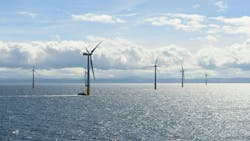IPF24: RWE official discusses regulatory challenges, opportunities for US offshore wind
Bruce Beaubouef * Managing Editor
NEW ORLEANS – There are considerable opportunities for wind energy development in US offshore areas, but the nascent industry needs to take advantage of the experiences and technologies made available by the offshore oil and gas industry. Those were among the themes and conclusions offered by Cynthia Pyc, Director of Permitting & Environment with RWE Offshore Wind Americas, at the recent IPF24 held in New Orleans.
Pyc offered her thoughts and comments at a panel entitled “Lessons from the Gulf of Mexico: new applications for proven approaches to energy development.” RWE had the lone winning bid in last year’s first-ever offshore wind energy lease sale in the Gulf of Mexico, and Pyc noted that her company is also advancing development plans for offshore wind energy in areas off the US east and west coasts.
Pyc noted that even in these early phases of development, there have already been some lessons learned for RWE; and, she added, hopefully for the relevant regulatory officials as well. She noted that RWE is currently in the process of site characterization in its US offshore wind energy projects off New York and California, a process that includes gathering data on geophysical and geotechnical characteristics in these areas. But there have been “regulatory hiccups” along the way, Pyc said. She noted that the US Bureau of Ocean Energy Management (BOEM) had recently put together a biological assessment for site characterization for the Pacific region. “And they naturally leaned on their East Coast colleagues who are also working in the offshore wind space.”
But Pyc noted that there’s a “a very big difference” between the East Coast and the West offshore areas, “and the most obvious one is that the water depths are quite different.” In the Atlantic, she noted the industry is planning to operate in 30 to 50 meters; while off the West Coast, the industry is planning to operate in 800 to 900 meters, “a depth that is much more analogous to the Gulf of Mexico than it is to the East Coast.”
As a result, Pyc commented, the agency’s biological assessment for the Pacific did not allow for or stipulate the use of autonomous underwater vehicles as a platform for collecting geophysical data. “They also didn’t include things like moon pools, which are regularly used by the oil and gas industry in the Gulf of Mexico to deploy ROVs,” she said.
“And because those things were left out of the biological assessment in the Pacific, we now have to reopen the biological assessment, which is a six to nine-month reset,” Pyc commented. “That kind of regulatory hiccup would have been avoided,” she added, “if the folks within BOEM had worked with their oil and gas colleagues in the Gulf to understand what the standard and typical platforms were.”
She noted that oil and gas companies operating in the Gulf have been using autonomous underwater vehicles to collect data on shallow-water areas and seabed hazards for more than 20 years. “So I think there are some real opportunities if we look beyond the wind sector conversation, and tap into the experience that exists in the Gulf of Mexico oil and gas sector.” The lesson for offshore wind developers and regulators, she said, is that “we really need to look outside of the sphere that we’re working in, which in this case is offshore wind, and really try to bring in the experience that other folks bring from other sectors.”
There are strong similarities and dynamics between offshore wind and offshore oil and gas, Pyc noted. “Both involve operating steel on water, gathering geophysical data, using autonomous vehicles, and complying with the Marine Mammal Protection Act. So we’re dealing with very similar activities,” Pyc said. “We’re often dealing with the same regulations and the same legislation, and sometimes even the same individuals in the offices. Going forward, we really have a great opportunity to avoid the kinds of hiccups” that RWE experienced in its site characterization efforts offshore California, in future offshore wind energy development projects.
“With every challenge, there’s a flipside, an opportunity,” Pyc observed. “And so I think that we have to acknowledge from the outset that the Gulf has a lot of experience and knowledge that we should tap into. There are almost 2,000 operating production platforms right now. There are exploration activities that are going on. There are construction activities with pile driving that will be very similar to what will be expected for the offshore wind market.”
Pyc noted that in the last couple of years, there have been many discussions within the US offshore wind industry about regulatory burdens, and trying to find efficiencies in that process. “With all of the oil and gas activity that the Gulf of Mexico has seen, they have found ways to implement process efficiencies that have enabled the issuance of hundreds of permits that are based on site characterizations and data-driven decisions. And so I think that the challenge that we have in the offshore wind industry is to try to and think outside of the box that we have created for ourselves. We have to tap into the lessons learned that already exist in the Gulf of Mexico, to implement those lessons learned, and incorporate those efficiencies into our processes.”
Pyc also observed that “currently, there is less regulatory burden associated with the permitting and construction of an oil and gas platform in the Gulf of Mexico than there is to build an offshore wind farm. And so we really need to ask ourselves, ‘how and why is that’? And how can we change that, so that we can meet the objectives that we collectively have, both from the regulatory agencies and the developers.”
A big part of the solution, Pyc concluded, “comes down to early discussions. If we had been involved in some of the early discussions around the biological assessment, with the experience that some of us have on all three coasts, and previously in the Gulf, we could have caught those things that were missing. So it really comes down to collaboration, but it also has to be quality collaboration, and it has to be early and often. We have to bring folks to the table who have the experience in different regions, so that we can fill in some of those gaps early on.” The key point, Pyc overserved, “is that the regulators should engage the developers early and often.”
05.05.2024
About the Author
Bruce Beaubouef
Managing Editor
Bruce Beaubouef is Managing Editor for Offshore magazine. In that capacity, he plans and oversees content for the magazine; writes features on technologies and trends for the magazine; writes news updates for the website; creates and moderates topical webinars; and creates videos that focus on offshore oil and gas and renewable energies. Beaubouef has been in the oil and gas trade media for 25 years, starting out as Editor of Hart’s Pipeline Digest in 1998. From there, he went on to serve as Associate Editor for Pipe Line and Gas Industry for Gulf Publishing for four years before rejoining Hart Publications as Editor of PipeLine and Gas Technology in 2003. He joined Offshore magazine as Managing Editor in 2010, at that time owned by PennWell Corp. Beaubouef earned his Ph.D. at the University of Houston in 1997, and his dissertation was published in book form by Texas A&M University Press in September 2007 as The Strategic Petroleum Reserve: U.S. Energy Security and Oil Politics, 1975-2005.

